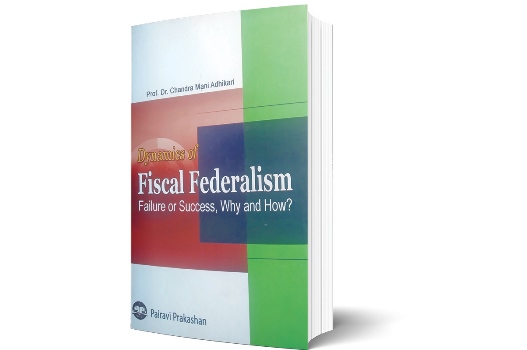A Useful Treatise On Fiscal Federalism

Mukti Rijal
The book reviewed in this column is authored by Dr. Chandramani Adhikari, who is a reputed economist in Nepal. Dr. Adhikari is known for the simple and intelligible way with which he can demystify and explain the complex notions of economics, federal governance and development. He contributes articles dealing with the status, consequences and impact of the economic policies on the ordinary life of the people.
His write-ups make even laypersons know and understand the complicated notions, contents and processes of the economy. His skills to articulate the issues of economic development in simpler and convincing terms have made him popular as an effective interlocutor in both print and electronic media.
The book introduced in this column is related to fiscal federalism, which is a vital ingredient of the federal polity. The success or failure of the federalization process depends upon the way the distribution of the fiscal resources is arranged, revenue and expenditure assignment is allocated.
The book comprises six chapters excluding annexes and tables. It contains more than two hundred twenty-five pages. The book is a kind of primer to understanding the notion, principles and practices of fiscal federalism drawing on the references and contexts from different federal countries from across the continents. The first chapter of the book is more or less introductory which provides the background, rationale and evolution of the concept of federalism, It discusses components of fiscal federalism, modes of fiscal arrangements, typology of grants and several other aspects of federal fiscal governance. Chapter two of the book elaborates on the global practices of fiscal federalism in which countries like Australia, Brazil, Canada, Germany, India, South Africa, Switzerland, the United States of America are basically covered.
The writer has also made a comparison of these federal countries with particular reference to the institutional arrangement and practices of fiscal federalism.
The interesting portion of this chapter is a discussion on the countries that reversed and rolled back into unitary structures due to failures to adopt federalism wisely and successfully.
According to the author, the countries like Indonesia, Mali Republic, Cameroon, Uganda, Yugoslavia are some of the examples where federalism was attempted or tied out but failed due to either internal or external reasons or circumstances. The book dedicates a separate description to fiscal federalism in a non-federal China.
A casual reading of the description shows the effective way with which China has managed to practice some kind of fiscal federalism even as politically it's a non-federal country with the centralized unitary state structures.
Chapter three of the book deals with fiscal federalism in federal Nepal introduced in 2015 following the promulgation of the constitution of Nepal enacted by the historic constituent assembly. The federal structure of the state has been discussed in the book with a special focus on the distribution of fiscal powers among the three spheres of the government. The chapter presents the tax and non-tax revenue powers of the federal, provincial, and local government and discusses in detail about the inter-governmental resource transfer arrangements.
Chapter Four of the book provides a highlight of the institutions and actors that play an important role in the operation of federal polity in general and fiscal federalism in particular. Parliaments, interstate council, Inter-provincial council, National Natural Resource and Finance Commission (NNRFC), Intergovernmental Fiscal Council are some of the actors and institutions discussed in the book regarding their role in the vertical and horizontal intergovernmental transfers.
Chapter Five discusses the concept, practices of property taxation in different jurisdictions with a special focus on Nepal. Chapter six- the concluding chapter of the book- provides some recommendations for the successful functioning of federalism in Nepal.
The writer proposes to chalk out a long-term strategy for institutionalizing fiscal federalism in Nepal and suggests some key institutional reforms, which are worth considering. The contents and organisation of the book are undoubtedly appreciable. It has sought to cover various aspects of fiscal federalism that can be useful for policy makers, academics, and students of a federal polity.
Recent News

Do not make expressions casting dout on election: EC
14 Apr, 2022
CM Bhatta says may New Year 2079 BS inspire positive thinking
14 Apr, 2022
Three new cases, 44 recoveries in 24 hours
14 Apr, 2022
689 climbers of 84 teams so far acquire permits for climbing various peaks this spring season
14 Apr, 2022
How the rising cost of living crisis is impacting Nepal
14 Apr, 2022
US military confirms an interstellar meteor collided with Earth
14 Apr, 2022
Valneva Covid vaccine approved for use in UK
14 Apr, 2022
Chair Prachanda highlights need of unity among Maoist, Communist forces
14 Apr, 2022
Ranbir Kapoor and Alia Bhatt: Bollywood toasts star couple on wedding
14 Apr, 2022
President Bhandari confers decorations (Photo Feature)
14 Apr, 2022










